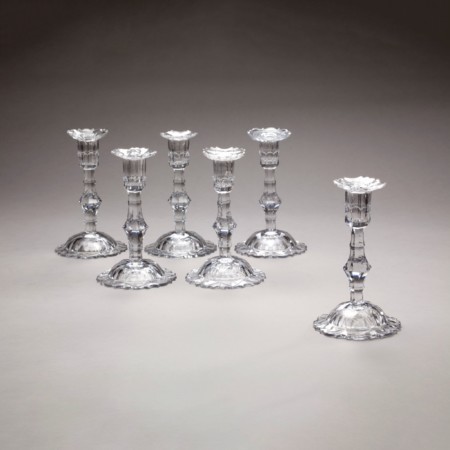
Engeland, 1760-1800
Three pairs of candlesticks with loose grease traps
Clear, colourless glass. Square thickened base, the underside cut in star shape. Stem with knot. Egg-shaped chalice, cut in facets and with diamond tips. Around the centre of the body a garland of leaves or chalices. The rim has a silver band with two lion heads and rings. The lid is missing.
Zoom inClear, colourless glass. Flat base, at the bottom a cut star. Curving oval-shaped body with scalloped rim with fans. Arched lid with pointed faceted knob. Lid cut in diamonds, diamonds and facets, body cut in diamonds and semi-circles, together forming a geometric (star) motif, deeply cut.
Zoom inA set consisting of tea caddy, teapot (EM 45-1946) and milk jug (EM 47-1946)
Zoom inA pair of Adam style salt shakers with blue-glass inner bowl
Zoom inOmstreeks het jaar 1648 schilderde Rembrandt (en/of zijn atelier) een aantal malen Christus naar hetzelfde model, als buste of als half-figuur, misschien ter voorbereiding voor zijn beide ‘Emmaüsgangers’ van dat jaar (nu in het Louvre en in Kopenhagen). De geschiedenis van die Christuskopjes gaat terug tot Rembrandt zelf: de inventaris van Rembrandts bezittingen bij zijn boedelafstand in 1656 vermeldt drie maal een “Christus tronie (kop)” waarvan één “naar het leven” geschilderd, dwz. geschilders naar een levens model. In deze stukken gebruikte Rembrandt als eerste in de Europese schilderkunst een joods model voor de Heiland. Dit portretje, door Bredius in 1911 na veel moeite verworven, bracht in de eerste helft van de 20e eeuw veel critici in bijna religieuze vervoering, vooral door de zachtmoedigheid van de gelaatsuitdrukking. Eén commentator vond zelfs: “dit werkje maakt het bestaan van de Nazarener aannemelijk, en is daarom een van de kostbaarste monumenten van Christelijke kunst”. Tot 1973 gold het stuk dan ook als de beste van Rembrandts Christus-bustes en twijfelde niemand aan de authenticiteit. Sindsdien is soms gezegd dat het stuk mogelijk niet (geheel) eigenhandig is.
Zoom inUitgelicht: Aert van der Neer schilderde voornamelijk ‘maneschijntjes’, branden en ‘wintertjes’ zoals dit exemplaar. Hij was een van de kunstenaars die omstreeks 1655 het winterlandschap tot perfectie brachten. Ons schilderij dateert uit die tijd en geldt als één van zijn beste. Wij zien bedrijvigheid van kolfspelers, vissers bij een wak en schaatsers, maar de nadruk valt op de verstilde, winterse atmosfeer. In het weergeven hiervan is de in zijn eigen tijd onopgemerkte van der Neer een waar meester. Bredius erfde het stuk van zijn grootvader, die het kocht in 1810.
Zie voor aanvullende informatie: Museum Bredius: Catalogus van de schilderijen en tekeningen, A. Blankert, cat. 111, blz. 152
Zoom inHoewel Abraham Bredius bij zijn aankoop in 1921 er ook van overtuigd was dat Rembrandt de maker was van de schets, hebben kunsthistorici de schets later afgeschreven.
Jeroen Giltaij kwam tot de conclusie dat de schets wel degelijk door Rembrandt is vervaardigd.
Na verwijdering van de vergeelde vernislagen en van de 19de-eeuwse overschilderingen, bleek het `handschrift` van Rembrandt nog beter te herkennen.
Daarna werd technisch onderzoek verricht door restaurator Johanneke Verhave van Restauratie Atelier Rotterdam en Petria Noble van het Rijksmuseum. Zij hebben niets geconstateerd dat een toeschrijving aan Rembrandt tegenspreekt.
Meer over dit schilderij:
> Zie: hier de documentaire over het onderzoek.
> Lees hier: hoe deze nieuwe toeschrijving tot stand is gekomen.
Landscape drawing of a view of Haarlem. According to Knuttel and Rosenberg, this drawing together with the drawings ‘Gezicht op Haarlem’(T 94-1946) and ‘Gezicht op Haarlem’, (T 95-1946) are from the same sketchbook.
Zoom inLandscape drawing of a view of Haarlem. According to Knuttel and Rosenberg, this drawing together with the drawings ‘Gezicht op Haarlem’(T 94-1946) and ‘Gezicht op Haarlem’, (T 96-1946) are from the same sketchbook.
Zoom inThe bowl is decorated in underglaze blue. The sides show a narrative depiction of Long Thighs, fools and immortals. At the top on the inside is a wide napkinwork border in blue. The catalogue lists the bowl as part of a set with OCVO-42-1946 and OCVO-46-1946.
Zoom inA set consisting of a cabaret (presentation tray) with five (originally six) cups. The model of the cup consists of four lobes with a C-shaped ear. The cabaret is also four-pass lobed with two open handles. One of the handles has been broken off and glued. Liqueur sets first appear in 1739; they were used during the drinking of coffee.
Zoom in